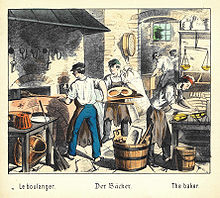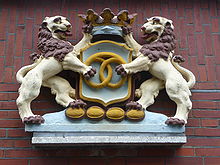Baker's trade
The bakery is one of the oldest commercial handicraft activities around the production of food ( food handicraft ).
history
Bread is one of the oldest man-made foods. Archaeological finds show that grain such as millet and sorghum was grown and processed in North Africa around eight thousand years ago . At that time there was probably only unleavened flatbread that was roasted on hot stones. The ancient Egyptians (2650–2000 BC) already knew how sourdough worked and produced at least 16 different types of bread. Wealthy households employed servants whose main job was to grind flour and bake bread. High officials even had their own bakeries, in which, among other things, food for temple staff as well as display and sacrificial bread was baked.
In the regions that are part of Germany today, the baker's profession has been known at least since the time of Charlemagne (768–814). At that time, it was mostly serfs who worked on Fronöfen or monastery servants on monastery ovens. Due to the growth of the cities, the baker's profession emerged as a “free” profession in the 10th century. The job title “Beck” (short for becker) or “Pfister” (from the Latin “pistor”) was used. At first, very few bakers had their own oven. They baked their goods in the city's own ovens, in which the bakers had to take turns.
For the general population, bread only played a role as a staple food since the late Middle Ages , as bread was too expensive until then. Instead, much of the population ate porridge. From around the 12th century bakers organized themselves in guilds that represented their interests in politics and regulated competition among themselves. Among other things, guilds procured work materials and raw materials for their members, established training standards, checked the quality of goods, set prices, wages and working hours and also took care of the old-age and health insurance of members. Bakers who did not adhere to the guild rules were severely punished and, in the worst case, were banned from working. With the increasing spread of the baker's profession, specialization began, which in turn was organized in new guilds. A distinction was made between the black baker, who makes rye and half-white bread, and the white baker, who makes all kinds of yeast and milk bread products and cakes. In southern Germany the guild of "Lebküchner und Pfefferküchler" was formed, while in the Hanseatic cities, for example, the bakers of Schiffszwieback organized themselves as "hard bakers".
At the beginning of the 19th century, the guilds lost their power and were dissolved. There was freedom of trade so that everyone could freely choose their profession. The baker's production methods had remained simple over the centuries. Laborious craftsmanship dominated everyday work. Significant work facilitation through machines took place in Germany only after the Second World War. Craftsmanship is still the basis for successfully running a craft bakery, but the use of machines also makes the job attractive for women. A quarter of all apprentice bakers today are women.
Organs and associations
The UIBC (International Union of Bakers and Confectioners) is the world association of bakers and confectioners. A total of 39 member associations from 34 countries have come together. Its tasks include advising members, representing them before international authorities and organizations, and defending common cultural, economic and social interests. The UIBC also deals with issues relating to vocational training, technology, quality, sales and taxation.
The CEBP, Confédération Européenne des Organizations Nationales de la Boulangerie et de la Pâtisserie, is the umbrella organization for national bakeries and confectioners' associations in Europe. The CEBP represents more than 190,000 European companies and advocates their interests in important questions of European food law, European consumer protection policy and environmental protection policy.
While the production of baked goods is mainly industrial in many countries, there is an organized bakery trade in German-speaking countries. The umbrella organization of the German bakery trade is the central association of the German bakery trade eV based in Berlin. Together with around 247 bakers' guilds and 16 regional guild associations, the central association represents the interests of German guild bakers. The three-tier association organization (guild, regional association, federal association) corresponds to the usual organizational form for all craft trades. The members of the central association are the state guild associations or their equivalent guilds . The organs of the central association are: 1. The General Assembly, 2. The Board of Directors and 3. The Presidium. Membership in the board, in the presidium and in the committees is an honorary position.
In 2008, the Central Association of the German Bakers' Trade also appointed the German National Bakery Team, which takes part in international baking competitions and represents the bakery trade at national events.
The promotion of the next generation is also a central point in the association's work. With initiatives such as “Bäckman” or the youth campaign “Back dir Your Future”, children and young people are specifically informed about the profession of baker. In addition to representing the interests of its member companies and promoting young talent, the central association provides knowledge on all aspects of bread culture, baked goods and the bakery trade via the website www.innungsbaecker.de.
Since 2013, the bakery trade has been celebrating the German bread culture annually on the Day of German Bread, which was officially entered in 2014 by UNESCO Germany in the nationwide register of intangible cultural heritage.
On the Day of German Bread 2016, the bakery trade announced the establishment of the German Bread Institute or the corresponding renaming and expansion of tasks, which is based on the quality inspection organization of the German bakery trade founded in the 1950s.
Initial and continuing education
All state guild associations and the central association jointly run the Akademie Deutsches Bäckerhandwerk Weinheim (Federal Technical School ), which accompanies training and further education as a non-profit organization in association with the technical schools of the state guild associations and promotes the professional development of the baking industry. Since 2014, the Academy has been offering the Certified Bread Sommelier / Certified Bread Sommelier training course. Around 18,800 young people are currently training to become bakers and bakery salespeople in German bakery shops, which is a little less than 10 percent of the workforce.
Market situation
The German bakery trade, with 12,155 guild companies and 275,200 employees on an annual average, ranks among the top group of German craft trades and one of the most important economic factors in Germany. With consumption of almost 62.4 kg of bread and baked goods per household and year in Germany for many years , the annual turnover in the bakery trade rose to almost 14 billion euros in 2015. With 1.03 billion visits in 2015, the German bakery trade is once again the front runner in the quick-service restaurant (QSR) segment of the out-of-home market. The bakeries can now book a fifth of all visits here (19.9%). For comparison: the market as a whole only recorded an increase of 0.4%.
Despite stable demand, the industry is experiencing a sustained process of concentration: The number of bakery businesses fell from around 55,000 (in the 1950s in the old federal territory) to 12,155 businesses all over Germany with around 47,000 sales outlets. (As of December 31, 2015). At that time there were mainly small family businesses in which sales were connected to the bakery, today the trend is developing towards central production facilities with a local or regional sales network. In many cases, branches are taken over by colleagues who are retiring. This favors the introduction of new technologies: flour silo systems, dough lines, EDP-controlled sales systems, ovens and cooling systems are no longer uncommon in craft businesses. They enable efficient, flexible production and, at the same time, the production of a greater variety of products. So z. B. the homemade dough pieces are stored refrigerated overnight and baked the next day in the bakery or in the sales room.
In addition to the variety of products, freshness and quality of baked goods, individual customer service in sales distinguishes the German bakery trade from industrial suppliers. The concentration in the food retail trade requires the bakery trade to constantly reorient its sales structures. Pre-bake stations in food retail and petrol stations as well as discount bakeries have further intensified competition. Due to the low purchase prices of frozen dough pieces, the narrow range, the simple equipment and the self-service concept, both sales channels can offer baked goods at discount prices. The bakery trade reacts to future market requirements and is no longer just a manufacturer and seller of baked goods. The focus is on making the craft and the special quality of the baked goods tangible and responding to customer requests. The bakery trade reacts by serving new trends such as front baking or bakery catering and the coffee business .
The customer request for organic products is relatively new, and interesting new markets are opening up here. With transparency in organically tested cultivation and in the procurement of raw materials, specialized bakers can win a large number of demanding customers.
literature
Web links
- UIBC (International Union of Bakers and Confectioners)
- CEBP (Confédération Européenne des Organizations Nationales de la Boulangerie et de la Pâtisserie)
- Central association of the German bakery trade
- Current facts and figures German bakery trade
- Academy of German Bakery Crafts in Weinheim
- Deutsches Brotinstitut eV (information and quality checks)
- History of the German bread culture
- Information on training as a baker and bakery salesman
- Information about bread and baking
- Information for children and families on baked goods and the bakery trade
- Information about the baker's roll
Individual evidence
- ↑ The German bread culture is an immarterial cultural heritage. German UNESCO Commission, January 1, 2014, accessed April 4, 2017 .


